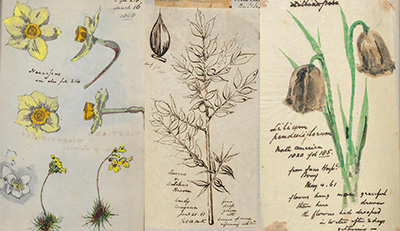
Extra-illustrations from Paxton’s Pocket botanical dictionary. Glass Case 580.3 P34, Special Collections, University of Auckland Libraries and Learning Services
An 1849 botanical dictionary in Special Collections provides a fascinating insight into the pursuits of a keen Victorian gardener who has personalised it with sketches, notes and pressed specimens.1
That gardener was one Richard Suter of Castle Hill, Maidenhead, based on an ownership inscription in the dictionary which matches the handwriting of most of the annotations.2 Richard Suter (1798-1883) was a London architect and surveyor whose work includes St Peter’s Almshouses in Wandsworth. Suter and his first wife Ruth Anne Burn (c1804-1854) were the parents of Andrew Burn Suter, the second Anglican Bishop of Nelson, New Zealand from 1867-1891.3
This annotated copy of A pocket botanical dictionary : comprising the names, history, and culture of all plants known in Britain … is one of only a few held in New Zealand libraries. A popular guide which reached multiple editions, the dictionary was compiled by Sir Joseph Paxton with assistance from botanist John Lindley (1799-1865).4 Paxton, perhaps best known as the architect of London’s Crystal Palace, was also a renowned gardener, author, publisher and MP.5
Catering to the strong Victorian interest in botany, the dictionary listed scientific and general information about plants in Britain, including recent introductions from distant lands. Paxton (1803-1865) told readers that with the dictionary in hand, `… the possessor or cultivator of plants may perambulate his own garden, visit those of his friends or public establishments, and attend floricultural exhibitions, in the full assurance that if any particular object engage his attention, he may at once derive every fact of interest…’6
It seems Richard Suter did plenty of perambulating. In notes dating primarily from the 1860s-1870s, he recorded plant sightings in and around Maidenhead, London and further afield, including a cuckoo flower `on the sloping ascent South Side of Poplar Station Nov. 27 65’. Suter also detailed who supplied cuttings, `geranium from Mr Shadwell of Slough Oct 24. 67’, from which countries plants originated, how they fared in his garden and tips such as `Mr John Higgs recipe for poisoning field mice.’
Suter’s annotations, drawings, watercolours and pressed specimens are on specially-inserted blank leaves and relate to the printed entries on the facing pages. These markings wonderfully bring to life some of the dry botanical listings, reveal a little of Suter’s life and times and ensure that this copy of the dictionary has research value beyond its text.
Jo Birks, Special Collections
References
1 J. Paxton and J. Lindley, (1849), A pocket botanical dictionary : comprising the names, history, and culture of all plants known in Britain : with a full explanation of technical terms, London : Bradbury and Evans. Glass Case 580.3 P34.
2 The handwriting also matches Richard Suter’s letters at the Alexander Turnbull Library and architectural plans at the London Metropolitan Archives.
3 J.S. Curl, (2006), A dictionary of architecture and landscape architecture (2 ed.), online edition, Oxford University Press; Katherine W. Orr. ‘Suter, Andrew Burn’, from the Dictionary of New Zealand Biography. Te Ara – the Encyclopedia of New Zealand, updated 26-Feb-2014; The Blain biographical directory of Anglican clergy, retrieved from http://anglicanhistory.org/nz
4 Richard Drayton, ‘Lindley, John (1799–1865)’, Oxford Dictionary of National Biography, Oxford University Press, 2004; online edn, May 2009. doi:10.1093/ref:odnb/16674
5 John Kenworthy-Browne, ‘Paxton, Sir Joseph (1803–1865)’, Oxford Dictionary of National Biography, Oxford University Press, 2004. doi:10.1093/ref:odnb/21634
6 Paxton and Lindley, (1849), p.vi.
Note: This was first posted to the now-retired Special Collections blog on 30 October 2015.
